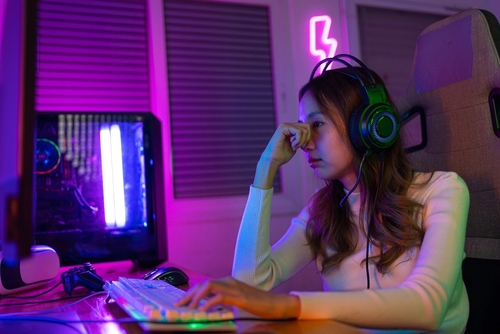
In this digital age, screens are an integral part of daily life. People spend hours each day staring at screens, from smartphones to computers to televisions. While this technology brings convenience and connectivity, it can also bring an unexpected issue—dry eyes.
The Impact of Screen Time
Excessive screen time results in dry eyes as prolonged focus on screens reduces your blink rate. Blinking is crucial to keep your eyes moist, and reduced blinking leads to dryness. Stay mindful of screen breaks to ease dry eye symptoms and maintain eye comfort.
How Does It Happen?
Your eyes have a thin layer of tears known as the tear film, which keeps them moist and comfortable. However, when you stare at screens, you tend to blink about half as much as you usually do. This reduced blinking means your eyes are not getting the moisture they need.
Symptoms of Dry Eyes
Dry eyes can cause various uncomfortable symptoms, including:
Burning sensation: a common symptom where your eyes may feel on fire or stinging. It can be uncomfortable and distracting.
Redness occurs when the blood vessels in your eyes become more visible, causing noticeable redness. It can make your eyes look tired or irritated.
Blurred Vision: Dry eyes can affect your vision, making it blurry. It is especially noticeable when focusing on something, like reading or using screens.
Sensitivity to Light: You may be more sensitive to light with dry eyes. Being in well-lit areas or outside on a sunny day can make it uncomfortable.
The Feeling of Something in the Eye: Some people with dry eyes have a sensation as if there is a foreign object in their eye. It can feel like a grain of sand or an eyelash is in your eye.
Watery Eyes: Interestingly, dry eyes can cause your eyes to water excessively. It is a paradoxical response where your eyes try to compensate for dryness by producing more tears. However, these tears often evaporate quickly, not providing the needed relief.
Preventing and Managing Dry Eyes
Blink Regularly: Make an intentional effort to blink more often when using screens.
Follow the 20-20-20 Rule: Every 20 minutes, pause for a 20-second break, and gaze at something 20 feet away to rest your eyes.
Use Artificial Tears: Use over-the-counter artificial tears to moisten your eyes.
Adjust Screen Settings: Ensure your screen is at eye level and not too bright to reduce strain.
Stay Hydrated: Stay well-hydrated by drinking plenty of water to support tear production.
Use a Humidifier: Using a humidifier in your workspace can add moisture to the air and prevent dry eyes.
When to Seek Professional Help
If dry eye symptoms persist despite self-care, consult an eye care professional promptly. Their expertise enables the exploration of advanced treatments, effectively addressing and alleviating any lingering discomfort. Seeking timely guidance ensures comprehensive care for your eye health and well-being.
It is essential to understand how screen time affects our eyes. Be aware of your screen use and take steps to protect your eyes. Remember to blink often, follow the 20-20-20 rule, and use eye drops if needed. If your eyes still feel dry, seek professional help. Your eyes deserve care to stay healthy in our screen-heavy world.
For more on dry eyes, visit Eyes on the City at our office in Seattle, Washington. Call (206) 588-2814 to schedule an appointment today.







